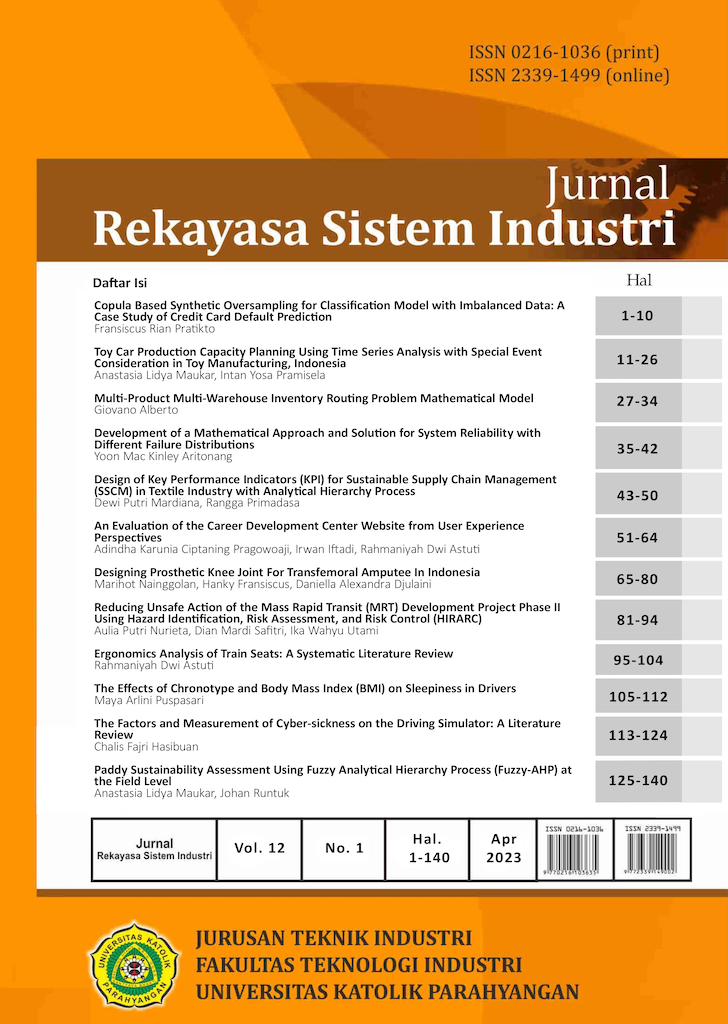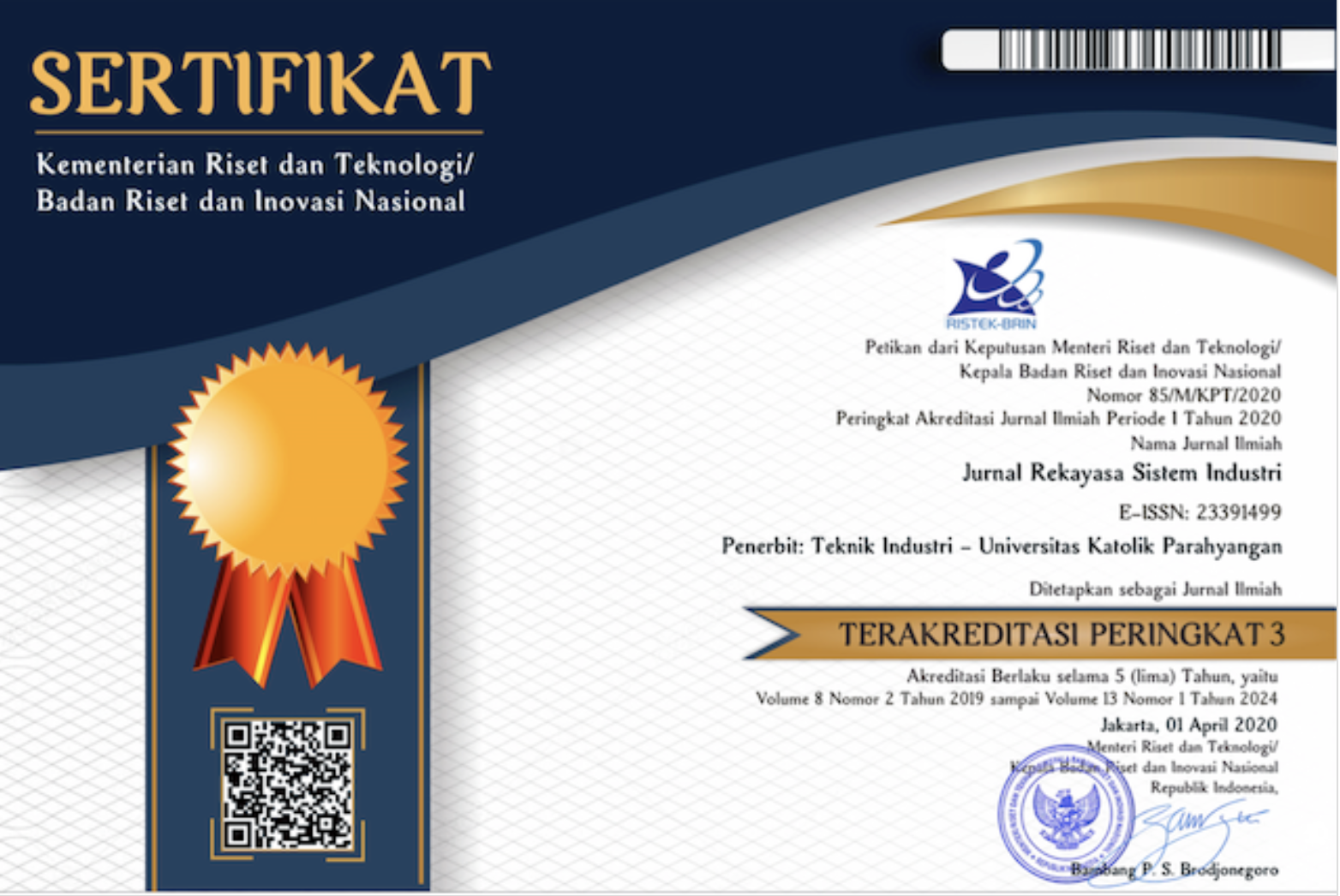Analisis Pengaruh Chronotype dan Body Mass Index (BMI) terhadap Tingkat Kantuk Pengemudi
DOI:
https://doi.org/10.26593/jrsi.v12i1.6546.105-112Kata Kunci:
Body Mass Index, chronotype, kantuk, pekerjaan mengemudiAbstrak
Salah satu penyebab utama meningkatnya angka kecelakaan di Indonesia adalah kelelahan dan kantuk yang menempatkan Indonesia di antara negara lain dengan tingkat kecelakaan tertinggi. Adapun elemen yang secara signifikan memengaruhi kelelahan dan kantuk adalah faktor individu yaitu chronotype dan Body Mass Index (BMI). Kelelahan dan kantuk dapat diukur menggunakan indikator sinyal EEG yang mana telah terdapat dalam beberapa studi terkait yang berfokus pada fluktuasi sinyal EEG dalam kondisi operasi tertentu, tetapi hanya sedikit yang meneliti efek chronotype dan BMI pada rasa kantuk. Penelitian ini bertujuan untuk menyelidiki hubungan antara kronotipe dan BMI dengan kelelahan. Kuesioner KSS dan indikator sinyal EEG digunakan untuk mengevaluasi kantuk. Temuan penelitian menunjukkan bahwa sinyal beta dan BMI pengemudi memiliki hubungan yang negatif, yaitu pengemudi dengan BMI tinggi lebih cenderung mengantuk daripada pengemudi dengan BMI rendah. Pada chronotype, tipe moderate morning menunjukkan peningkatan power Alpha dan Theta dibandingkan tipe lainnya, yang disebabkan oleh ritme sirkadian.
Referensi
Abe, T., Nonomura, T., Komada, Y., Asaoka, S., Sasai, T., Ueno, A., and Inoue, Y. (2011). Detecting deteriorated vigilance using percentage of eyelid closure time during behavioral maintenance of wakefulness tests. International Journal of Psychophysiology, 82, 269–274.
Akerstedt, T.. Ingre, M., Kecklund, G., Anund, A., Sandberg, D., Wahde, M., Phillip, P., Kronberg, P. (2010) : Reaction to sleepiness indicator to partial sleep deprivation, time of day, and time of task in a driving simulator - the DROWSI project. Journal of Sleep Research, 19,298-309
Badan Pusat Statistik Indonesia, Jumlah kecelakaan, korban mati, luka berat, luka ringan, dan kerugian materi yang diderita tahun 1992-2013. http://www.bps.go.id/linkTabelStatis/view/id/141, diunduh pada 3 Maret 2016
Cazzoli, D., Antoniades, C. A., Kennard, C., Nyffeler, T... Bassetti, C. L.. dan Muri, R. M. (2014) : Eye Movements Discriminate Fatigue Due to Chronotypical Factors and Time Spent on Task - A Double Dissociation. PLoS ONE,9, 1, e87146
Dawson, D., Sprajeer, M., dan Thomas, M. (2021). How much sleep do you need? A comprehensive review of fatigue related impairment and the capacity to work or drive safely. Accident Analysis and Prevention, 151, 105955
Di Milia, L., Smolensky, M. H., Costa, G., Howarth, H. D., Ohayon, M. M., and Philip, P. (2011), Demographic factors, fatigue, and driving accidents: An examination of the published literature. Accident Analysis and Prevention, 43, pp. 516-532
Girdhar, S., Sharma, S., Chaudary, A., Bansal, P., Satija, M. (2016). An Epidemiological Study of Overweight and Obesity Among Women in an Urban Area of North India. Indian Journal of Community Medicine, 41(2), pp. 154-157
Haltia, L. T., Rinne, J. O., Merisaari, H., Maguire, R. P., Savontaus, E., Helin, S., et al. (2007). Effects of intravenous glucose on dopaminergic function in the human brain in vivo. Synapse, 61, 748-756.
Hiestand, D.M., Britz, P., Goldman, M., Phillips, B., 2006. Prevalence of symptoms and risk of sleep apnea in the US population: results from the national sleep foundation sleep in America 2005 poll. Chest 130, 780-786
Hole, A. R. (2007). Fitting mixed logit models by using maximum simulated likelihood. The Stata Journal: Promoting Communications on Statistics and Stata, 7(3), 388–401. https://doi.org/https://doi.org/10.1177/1536867x0700700306
Jagannath, M, Balasubramanian, V. (2014). Assessment of early onset of driver fatigue using multimodal fatigue measures in a static simulator. Applied Ergonomics, 45, 1140-1147
Jap, B.D., Lal, S., Fischer, P. (2011). Comparing Combinations of EEG activity in train drivers during monotonous driving. Expert System with Applications, 38, 996-1003
Johns, M. W. (1998) : Rethinking the assessment of sleepiness. Sleep Medicine Reviews, 2.3-15
Johns, M. W. (2000) : A sleep physiologist's view of the drowsy driver. Transportation Research Part F, 3,241-249
Lal, S.K., dan Craig, A., (2001). A critical review of psychophysiology of driver's fatigue, Biological Physiology, 55, 173-194
Liu, J., Zhang, C., Zheng, C. (2010). EEG-based estimation of mental fatigue by using KPCA-HMM and complexity parameters. Biomedical Signal Processing and Control, 5, 124-130
May, J., Baldwin, C. L. (2009). Driver fatigue: The importance of identifying causal factors of fatigue when considering detection and countermeasure technologies. Transportation Research Part F, 12, 218-224
Messiah, S. (2013). Body Mass Index. In: Gellman, M.D., Turner, J.R. (eds) Encyclopedia of Behavioral Medicine. Springer, New York, NY.
Mills, P.J., Kim, J.H., Bardwell, W., Hong, S., Dimsdale, J.E., 2008. Predictors of fatigue in obstructive sleep apnea. Sleep Breath. 12, 397-399
Russo, M., Thomas, M., Thorne, D., Sing, H., Redmond, D., Rowland, L., Johnson, D., Hall, S., Krichmar, J., dan Balkin, T. (2003) : Oculomotor impairment during chronic partial sleep deprivation. Clinical Neurophysiology, 114, 723-736
Sellaro, R., S. Colzato, L. (2017). High body mass index is associated with impaired cognitive control. Appetite, 113, pp. 301-309.
Shope, J. T. (2006). Influences on youthful driving behavior and their potential for guiding interventions to reduce crashes. Injury Prevention, 12(suppl_1), i9-i14. https://doi.org/10.1136/ip.2006.011874
Taillard, J., Sagaspe, P., Phillip, P., & Bioulac, S. (2021). Sleep timing, chronotype and Social Jetlag: Impact on cognitive abilities and psychiatric disorders. Biochemical Pharmacology, 191, 114438
Ulleberg P. Rundmo T. (2003), Personality, attitudes and risk perception as predictors of risky driving behaviour among young drivers. Safety Science, 41(5), pp. 427-43. Available from: doi:10.1016/0925-7535(0100077-7
Wang, J., Li, Y. R., Jiang, C. Q., Zhu, T., Zhu, F., Jin, Y. L., Lam, T. H., Cheng, K. K., & Xu, L. (2022). eClinicalMedicine. Chronotype and cognitive function: Observational study and bidirectional Mendelian randomization, 53. https://doi.org/10.1016/j.eclinm.2022.101713
Williamson A., Lombardi D.A., Folkard S., Stutts J., Courtney T.K., Connor J.L. (2011). The link between fatigue and safety. Accident Analysis and Prevention, 43, 498-515
Yilmaz, V., &: Celik, H. E. (2004). A model for risky driving attitudes in Turkey. Social Behavior and Personality: an International Journal, 32(8), 791-796. https://doi.org/10.2224/sbp.2004.32.8.791
Zhang, G., Yau, K., Chen, G. (2013). Risk factors associated with traffic violations and accident severity in China. Accident Analysis and Prevention, 59, 18-25













